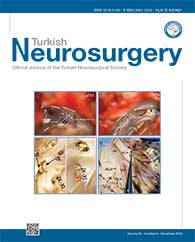2Lishui Municipal Central Hospital, Department of Neurology, Lishui, China DOI : 10.5137/1019-5149.JTN.33034-20.2 AIM: To construct a reliable prediction model for pediatric atypical teratoid/rhabdoid tumor (ATRT) patients.
MATERIAL and METHODS: Population-based data of patients diagnosed with intracranial ATRT were extracted from the National Cancer Institute?s Surveillance, Epidemiology, and End Results database. These patients were randomly assigned into training and validation cohorts at a ratio of 2:1. Univariable and multivariable Cox analyses were conducted to determine independent factors of overall survival (OS). A nomogram was then developed using the covariates with the best prognostic value, and the predictive performance of the nomogram was assessed by calibration curves, concordance index, time-dependent receiver operating characteristic curve analysis, and decision curve analysis.
RESULTS: A total of 267 cases were included. The OS rates at 6 months, 1 year, and 3 years were 61.6%, 50.1%, and 35.4%, respectively. The results of multivariable Cox analysis showed that tumor extension, surgery type, radiotherapy, and chemotherapy were independent prognostic indicators. A nomogram integrating these factors was established to predict the 6-month, 1-year, and 3-year OS rates. This prediction model was validated in the validation cohort. The nomogram had favorable predictive performance and discrimination ability.
CONCLUSION: We developed and validated a novel nomogram with favorable discrimination ability to predict prognosis for newly diagnosed pediatric ATRT patients. Although additional validation is required, this may be a useful tool in clinical decision making.
Keywords : Atypical teratoid/rhabdoid tumors, SEER program, Nomograms, Predict, Overall survival




